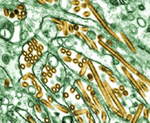Surveillance Experts Find New Route for Avian Flu
 |
H5N1 avian flu viruses (gold) growing in animal cells (green)
CREDIT: CDC |
Before 1997, flu researchers believed that avian influenza A viruses could not infect humans directly. For an avian flu virus to infect a human, scientists thought it would first need to pass through another animal, particularly one that can be infected by both bird and human flu strains, such as a pig. Genes from a bird strain would mix and match with genes from a human strain, and a new strain would develop, this one potentially infectious to people. After 1997, the year in which 18 people in Hong Kong were infected with the H5N1 flu strain, the chicken was found to serve as an intermediate animal as well. Now NIAID-supported researchers Robert G. Webster, Ph.D., St. Jude Children's Research Hospital, Kennedy F. Shortridge, Ph.D., University of Hong Kong, and senior author Yi Guan, Ph.D., also of the University of Hong Kong, and others have discovered a new route that an avian flu virus can take. The researchers have monitored birds in live-poultry markets in China since July 2000. By determining how many birds are infected with flu viruses and which viral strains they are carrying, the scientists are searching for clues into the source of the next possible pandemic.
 |
| Robert G. Webster, Ph.D. |
Among other things, Drs. Webster, Shortridge, Guan, and their colleagues found that gene segments of H9N2 flu viruses in ducks had undergone many changes, with some new combinations coding for antigens that could infect humans. They concluded that the H9N2 virus was transmitted from a duck to a chicken, back to a duck, with the human-infecting antigens along for the ride. In this way, not only can a flu strain pass directly from a duck to a human, but the high degree of gene assortment inside the duck increases the chance that a new strain will develop that will be transmissible from one person to the next.
This information is based on the article "Characterization of H9 subtype influenza viruses from the ducks of southern China: a candidate for the next influenza pandemic in humans?," from the Journal of Virology.
References
Related Links
Non-government
back to top